Panama Overseas Adventure Travel Trip - Oct 22 to Nov 2, 2010
photos by Bill & Barbara Bowman and Bruce Anderson & Cathy Grant
Instructions: Maximize this window. As you scroll down, you should see two photos side by side. If not, you should change your zoom level.
OAT web site http://www.oattravel.com/Trips/2010/Panama-Canal-Cruise-and-Panama-A-Continent-Divided-Oceans-United-2010.aspx
Bocas del Toro pre-trip
Thursday, October 21, 2010: Travel Day
It was long day of travel, starting with a three hour drive to
Syracuse with the windshield wipers in full action. No problem
parking at the airport. We checked in and waited a few hours,
then flew to Atlanta, Georgia where we had a rapid ride on an
underground train to get our gate.
After a four+ hour flight (Bill watched a bad movie with bad
earphones and Barbara started a book). When we arrived at Panama
City it was early evening. We navigated the line up through
Customs. Our guide, JosÚ, was there as scheduled wearing a red
Overseas Adventure Travel (OAT) shirt and holding up a bright
yellow OAT sign. Several trip members joined us and we hopped in
a van for a half hour ride to El Panama Hotel.
1.3 million people in Panama city. Lots of highrises. As we had
to be down in the lobby at 6 am for our breakfast, then fly to
Bocas del Toro, we got to bed – it was midnight!
Friday, October 22, 2010: Bird Island Day
This morning we got up at 5am to get ready for our trip to Bocas
del Toro, on Colon Island on the Caribbean Sea (Panama City is on
the Pacific Ocean). This is three day pre-trip before the longer
Panama trip. We had an early breakfast at the hotel. JosÚ then
told us our flight was delayed an hour but he decided to get us
to the small local airport right away as our van had arrived. The
van took a toll road so it wasn’t long before we arrived at
the airport, very close to the mouth of the Panama Canal.
The long wait gave us a chance to meet our fellow group members
– 11 of us, a dozen counting JosÚ. The group was all
Americans (except us). Bill was delighted that Catherine (from
San Francisco, on her 10th OAT trip) was an avid birder. Bruce
(from Houston, on his 17th OAT trip) had the misfortune of lost
luggage. He was in long pants and a blue shirt until his luggage
finally arrived at Bocas del Toro on Saturday morning.
As we were delayed flying to Bocas del Toro, we did not arrive
until noon.
We checked into a large bright yellow hotel, the Playa Tortuga, all rooms facing the beach. Lovely. The power was off in our room – had to be activated by a room access card each time we returned.
We did have a good afternoon, first visiting Bird Island by boat
– a spectacular rock formation with outcroppings and trees,
and Brown Boobies, Yellow-crowned Night-herons, Crimson-billed
Tropicbirds....
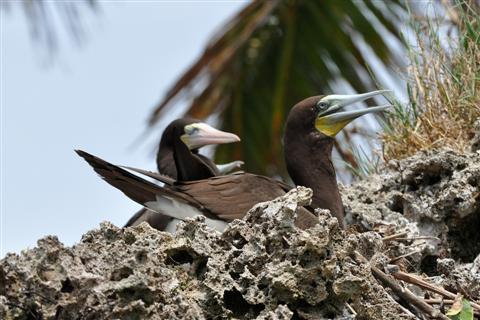
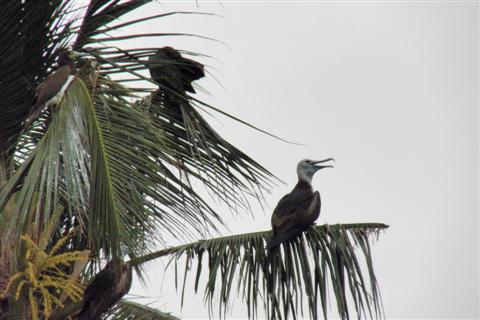
We stopped at a nice local spot for lunch. Sea bass, coconut
rice, salad and our first Panama beer: Balboa. Then we toured
about in the water, completing the circuit around Colon island.
We stopped to look down at huge red starfish – very hard to
the touch.
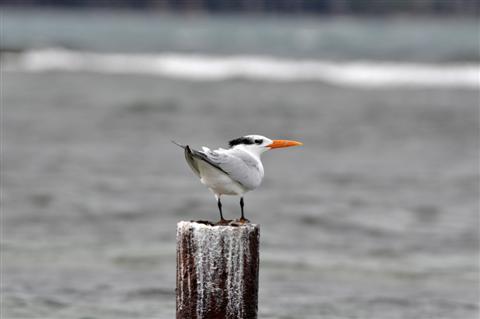
First thing upon returning, a quick shower to wash off our sandy
feet and sample our second Panama beer: Panama. We checked out
the birds at a horse farm behind our hotel while others in the
group tried out the swimming pools.
As we had a fulsome late lunch, our group decided to stay at our
hotel for dinner. We had some hearty salads and tea by the water,
listening to the waves
It is hot and humid over here on the Caribbean Sea but we are
adapting.
Birds Today (see all the bird photos at http://web.ncf.ca/ed143/Panama/Panama
birds.htm )
1. Rock Dove
2. Great-tailed Grackle
3. Ruddy Ground Dove
4. Great Egret
5. Black vulture
6. Magnificent Frigatebird
7. Tropical Kingbird
8. Mangrove Swallow
9. Ringed Kingfisher
10. Brown Booby
11. Yellow-crowned Night-heron
12. Crimson-billed Tropicbird
13. Brown Pelican
14. Cattle Egret
15. Little Blue Heron
16. Royal Tern
17. Spotted Sandpiper
18. Clay-colored Robin
19. Louisiana Waterthrush
Saturday, October 23, 2010: Sloth and Red Frog Day
This morning we enjoyed breakfast in a thatched roof gazebo over
the water. We spotted a river entering the ocean not far away so
decided to hike over, seeking more colorful birds. We hiked along
a road, sharing it with trucks, bicycles with passengers on
handlebars, joggers... Our attention was on the many birds
singing – the fly catcher birds were busy finding their
breakfasts. Hibiscus hedges were stunning. When we returned to
our hotel, Bill booked Catherine for an early morning expedition
for tomorrow.
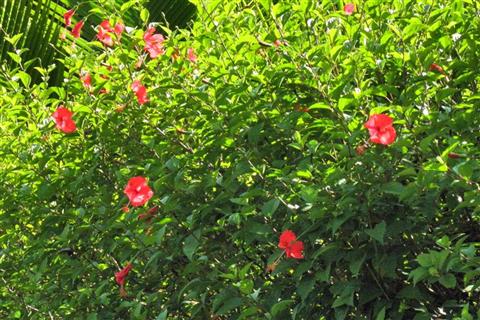

Our planned 10am departure by boat for activities today was
delayed as JosÚ had to travel to the airport for Bruce’s
luggage. Luckily everything came back to him except a few
batteries.
We hopped into our boat again and headed for Mangrove Forest,
Dolphin Bay and Red Frog beach. It was a day of discovery. As our
boat wended through the mangrove islands, we were reminded of our
trip to the Everglades. We spotted a few bottle nosed dolphin
fins in Dolphin Bay. The dolphins live here year round feasting
on jellyfish.
We passed Carlos, a local fisher in a dugout canoe busy catching dinner for his family. Then we stopped at a snorkeling dock and swam around with our masks checking out the ocean bottom. The water was quite shallow so we could stand up in places. Certainly the plants and small fish looked much brighter through the mask. Bill lucked in with his underwater camera capturing some colourful fish. The water was warm and clear – refreshing. Not like the Atlantic Ocean we know. We ate our lunch beside the water sipping some Panama cerveza.
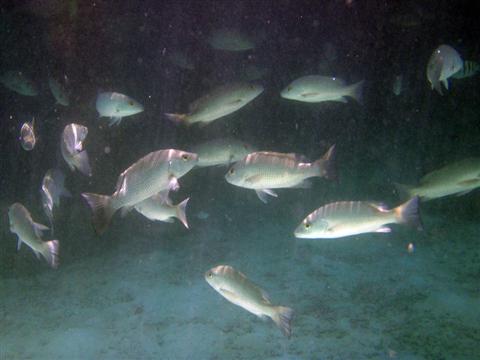
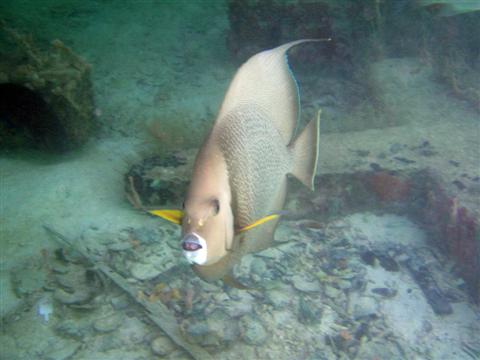
After lunch, back in the boat and over to Red Frog beach. After
you get off at the dock, you hop in the back of a truck, the Red
Frog Express, for a quick shuttle to the other side of the
island. On our way to the truck, JosÚ spotted a large sloth up
in a tree. This reminded us of Grant’s school project on
sloths – this was a three toed one. It was a large brown
blob. When we returned a few hours later we were able to spot a
baby sloth beside it. The adult stretched her long hairy arms and
we able to binocular spot the three toes (fangs).
Unfortunately the red frogs have to share the beach area with
volleyball players, sunbathers and swimmers. The large turquoise
breakers were amazing. We hiked to an impressive outlook with a
spectacular ocean view, then enjoyed riding the big waves. JosÚ
hired a couple of young indigenous boys to show us the red frogs
in the forest adjacent to the beach. The frogs are very little,
about half the size of a fingernail, so it was good to have
spotters.
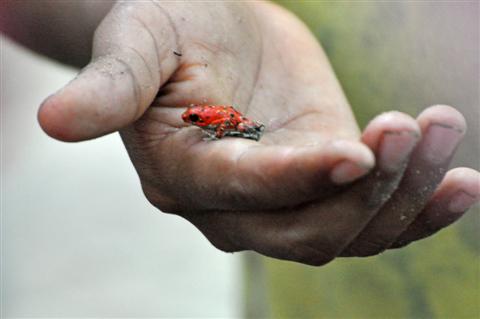
After a hot day on the water we returned much reddened and very
happy, to try our third Panama beer: Atlas.
Our group decided to travel into town for dinner. We packed our
rain gear as big dark clouds were gathering. Diane and Frank
(from Aspen, Colorado, on his 19th OAT trip) had made a
reservation at a sushi restaurant. We decided to find another
spot so JosÚ and our four group members who were first
generation Americans (from the Punjab, NW India) decided to look
for something else (they are vegetarian). Amazingly, across the
street was Om’s restaurant – “there’s no
place like Om’s”.
I
t was an Indian restaurant. Although the owner was on vacation,
Harcharan (from Charlotte, NC) could tell by his name that he
came from the Punjab also. Amarjit (from Bufalo, NY) generously
treated us to dinner starting with aperitifs of pakoras and
samosas – yum! They advised us about the various selections.
Bill was happy with his chicken and Barbara enjoyed her creamed
spinach. JosÚ found some of the food on his large variety plate
too spicy – it was a first try for him. Adding to the
experience was a heavy rainstorm, so we quickly moved our table
away from the open balcony. Quite a special evening, capped off
by Indian desserts (from Toronto!) back at the hotel.
New Birds Today
20. Great Kiskadee
21. Montezuma Oropendula
22. Bay-breasted Warbler
23. Eastern Wood Pewee
24. Black-cheeked Woodpecker
25. Bananaquit
26. Semi-palmated Plover
27. Rufous-tailed Hummingbird
28. Anhinga
29. Hook-billed Kite
30. Blue-winged Warbler
Sunday, October 24, 2010: San Christobal Day
It would be hard to say goodbye to this idyllic spot. We were
fortunate it was not the busy tourist season so we enjoyed the
wildlife and scenery without distractions.
As a last adventure, JosÚ planned a visit to a local indigenous
village, San Christobal, on another island. It was not a tourist
destination so we were lucky to see it in its natural state.
We walked through the village of small huts on stilts and
hiked along a river on a muddy path until we turned back when we
reached a gully crossing on a narrow slippery log. Bill tried it
and decided it was risky for camera equipment. A mother with a
baby and some very young children had just crossed it. Their bare
feet were accustomed to the crossing. A little boy ran back and
forth on the log to show us how easy it was. In the main village
there were cement walkways with large ditches on each side.
Barbara’s Hallowe’en pencils were popular with the
children. They seemed happy and looked well. There was a medical
clinic in the village and three schools, with over one hundred
children attending all together. The school program ends at Grade
9. Catherine, a retired elementary school principal, and Barbara
reflected on how happy the young children seemed even though they
had so little compared to most North American children.
We finished our visit to the area with a stop at the village of
Bocas Del Toro where we had lunch and birded in the village park.
From there, we went to the airport for our flight back to Panama
City. There was a soccer game in action right at the end of the
runway. Homes backed on the runway. It reminded us of the Quito
airport landing strip.
A few of us decided to try a little Italian restaurant near the
hotel. Excellent. When we returned to El Panama, Cathy and Bruce
had just checked in. We enjoyed one of the hotel’s free
drinks and celebrated together.
New Birds Today
31. ? Hummingbird
32. Lesser Seed-finch
33. White-collared Seedeater
34. Lineated Woodpecker
35. Snowy Egret
36. ? Warbler
37. ? Hummingbird
38. Blue-gray Tanager
39. ? white breasted birds
40. Gray Hawk
Main Trip - Panama Canal, a Continent Divided & Oceans United
Monday, October 25, 2010: Panama City Day
This was the first day of the official Panama trip. It started
with a meeting of our enlarged group – 24 persons counting
JosÚ.
There were new introductions. The four of us were the only Canadians. JosÚ explained the itinerary for the upcoming week. We would be staying on the Pacific Ocean, visiting a rain forest lodge and travelling though the Panama canal. Incredibly, at breakfast, Catherine found some good birds right in the pool area of the hotel. As a good omen, we discovered that almost everyone was wearing Keen sandals.
Today was a tour of the city. We enjoyed visiting Panama Viejo,
the old city, and Colonial Panama. We absorbed a lot of Spanish
invasion history, starting in the early 1500s.
Cathy had researched good local restaurants online and,
coincidentally, we stopped for lunch, at the first one on her
list, El Trapiche. This was a real treat. Among the four of us we
sampled sea bass with lime, octopus, chicken in a tomato sauce,
rice with a variety of nuts, corn cakes... Panamanian food is
tasty; it is not spicy.
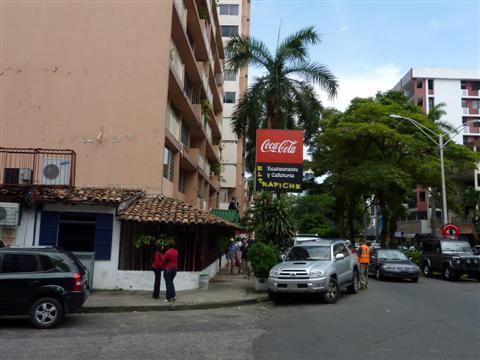
In the evening we travelled to the Miraflora Locks where we
marveled at some huge tankers coming through in both directions,
guided by powerful electric towing locomotives,
”mules”, linked to them by wire. It was dark and rainy
making the movement rather surrealistic.
We had a special buffet dinner at the restaurant by the locks
followed by some animated Panamanian dancing. We were all tired
when our bus returned us to El Panama.
New Birds Today
41. White-ringed Flycatcher
42. Red-crowned Woodpecker
43. ? Hummingbird
44. Turkey Vulture
45. Orange-chinned Parakeet
46. Streaked Flycatcher
47. Tropical Cormorant
Tuesday, October 26, 2010: San Carlos Day
Today we travelled west fom Panama City, arriving at San Carlos
on the Pacific Ocean about 11am. We passed several buses bringing
workers into Panama City. They were used school buses from the
US, colourfully painted by their owners.
We toured about the town, visiting a fruit vendor and some local
artisans.
At noon we arrived at the school. OAT is supporting this school, currently by providing the building supplies for a new cement block classroom. Parents provide the construction labour on weekends. The school has morning and afternoon shifts to accommodate several hundred children. We were individually guided by young children to a small auditorium. We were listened to them sing the Panamanian national anthem. The Americans (many of our group members were teachers) spontaneously sang God Bless America. We four Canadian non-singers decided to applaud and hope we weren’t expected to sing O Canada. Luckily we moved on to some lively Panamanian dancing. The children wore beautiful outfits – very impressive. Some of our group, including Cathy, joined the dancers for the final dance. We all put the school supplies we had brought in a large basket (we had brought several packages of Hallowe’en pencils). Then we toured the school – the older children were now in class.
We were bused for lunch with several local families. We were
greeted by a family with three young sons and their grandmother.
We were treated to an amazing lunch prepared by the grandmother.
She served plates of jumbo shrimp, chicken, rice and fried
bananas. For dessert we had apricots with cherry ice cream and
watermelon. She had made room in her tiny home for the six of us
and we felt very privileged. As requested by OAT, we each
presented her with a gift from our country (we had brought a tea
towel with images of the Canadian north, inukshuk, polar bears,
seals, etc.).
It was a short bus drive to our hotel, the Solarium, which was
right on the Pacific Ocean at Coronado. It didn’t take us
long to join Cathy and Bruce for a hike along the beach. It was
hot and windy – pony tail time for Cathy and Barbara. The
tide was coming in and the waves were pounding the shore –
the Pacific tides are much higher than the Caribbean tides. It
was a black sand beach showing evidence of volcanic action. A
variety of shorebirds, whimbrels, willets and sandpipers, were
dancing along the edge of the incoming waves.
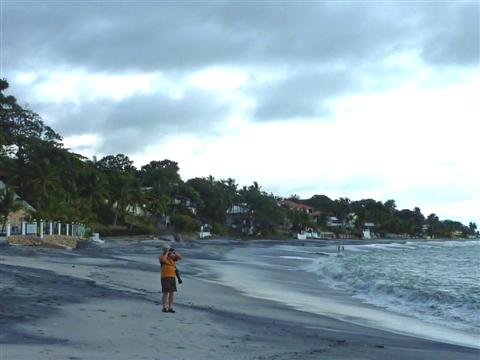
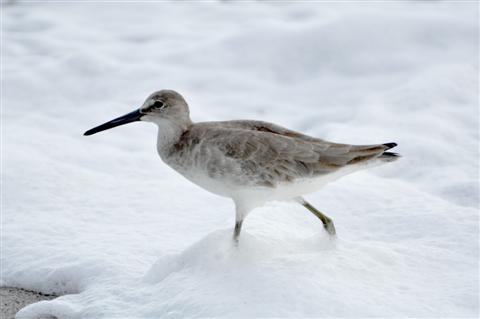
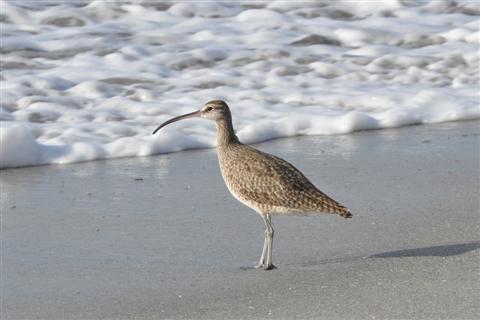
Our group got together for dinner at a local restaurant. A
pleasant way to end our day.
New Birds Today
48. Crimson-backed Tanager
49. Palm Tanager
50. Yellow Warbler
51. ? Flowerpiercer
52. Tennessee Warbler
53. Variable Seedeater
54. Willet
55. Whimbrel
Wednesday, October 27, 2010: El Valle de Anton Rainforest
Day
Today we drove from the ocean up into the surrounding mountains.
Spectacular scenery. Bill anticipated good birding. Our first
adventure was a hike along a rock trail. They provided wooden
walking sticks which kept us from falling on the steep slippery
descent. We crossed two suspended bridges over a rushing stream.
The Chorro del Macho waterfall splashed over a rocky drop from
high above. Of course, Bill‘s binoculars were busy and he
spotted some colourful birds, still to be identified. We then
hiked to a large pool in a stream. Several us went for a
refreshing cool swim.
After our hikes, it started to rain heavily – it rains
every day here. Luckily we were in the bus on our way to Rincon
Vallero, a local lodge/restaurant where we enjoyed the usual hot
lunch of sea bass, rice and plantain. Dessert was red jello
covered with melted vanilla ice cream and whipped cream –
very sweet. As it was JosÚ's birthday (29), he was presented
with a special cupcake.
After lunch we visited the local market where there was a folk
festival underway. We were treated to more Panamanian dancing.
Cathy and Bruce talked to the festival organizer who,
surprisingly was a young Canadian, Michael Ducharme, from Windsor
who has lived in El Valle de Anton for three years. He is the
President of their Chamber of Commerce.
Bruce and Barbara bought some more local beer to sample before
dinner. Bill has devised a way to cool it quickly using a plastic
garbage pail from our hotel room and filling it with ice (ice
buckets are too small).
As it was still raining Barbara made good use of her birthday
yellow umbrella and Bill wore his rain cape to protect his
camera.
The Solarium hotel had planned a special dinner for us at was
JosÚ’s 29th birthday. Our group was treated to a barbeque
on the top floor of our hotel/condominium (only the first five
floors were hotel). It was a magnificent view. Catherine and
Ellie had organized a birthday card signing (back of one of
JosÚ’s large Panama maps), and invited us to contribute
something fun for a gift bag (we contributed a Canada pencil and
a photo print of JosÚ with a chocolate cupcake with a candle,
taken at lunch; Cathy and Bruce contributed some rum). Barbara
(with some help from Cathy) prepared a “test” (JosÚ
was always giving us tests) – 29 questions about our group,
about Panama and about JosÚ himself. When asked who was the
youngest member in the group (the answer was JosÚ), he guessed
Cathy, who said he was right. Entertainment also included a
pi˝ata and a birthday cake. JosÚ was delighted when a friend
from Panama City arrived. It was fun for us to celebrate
together.
New Birds Today
56. Sanderling
57. Eastern Kingbird
58. Tawny-crested Tanager
59. Baltimore Oriole
60. Broad-billed Motmot
61. Lesser Nighthawk
Thursday, October 28, 2010: Miraflores Locks Day
Today we travelled from Coronado on the Pacific to Gamboa on the
Chagres River, north of Panama City.
Our first stop was to visit a local family who were selling
cashews. It was a large family of several generations,
includingmany children. An eighteen year old daughter was
pregnant with her second child. An older son was building a place
of his own made of cement blocks behind the family home. A small
toilet and homemade shower were behind the house. Chickens, dogs
and puppies were running about. Very different from our North
American lifestyle. They showed us their cashew tree and JosÚ
explained how they roasted the nuts. The cashews for sale quickly
sold out.
Our next stop was a local artisans market where we all found some
treasures. Our rain gear got another workout.
As it was raining, we ate our bag lunches (from the Solarium
hotel) on the bus as we travelled to the Miraflores locks. These
are the first locks on the Pacific side. We thoroughly enjoyed a
tour of the Miraflores Visitor Center and museum. Luckily we were
able to see some huge tankers passing through – one just had
a two foot clearance on each side. The maximum size ships are
known as Panamax. The highest canal passage price was a Norwegian
cruise ship – over $490,000. Charges are based on size,
weight and number of persons aboard. Prices are high now to pay
for canal expansion.
Our bus then brought us to Gamboa Rainforest Resort on the
Chagres River. Bill headed right out to bird in this well known
birding hotspot. We noticed a hammock in on a local porch very
similar to the one Barbara’s mother brought us back from
Costa Rica over twenty years ago.
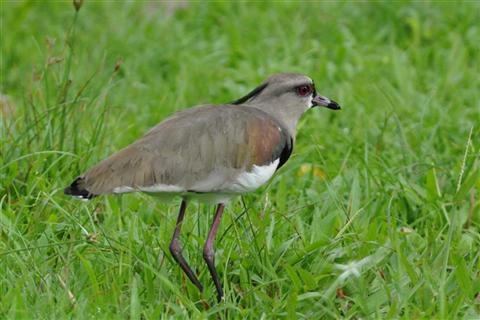
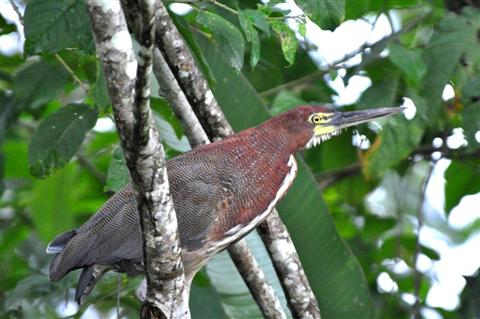
We had a quick supper (pizza and nachos) in the bar so we could
participate in a night safari. We travelled in an open wagon with
seats and a guide shone a bright flash light at the undergrowth.
We spotted a family of capibara (very large rodents), agouti
(small rodents), a caiman, a large group of Black-bellied
Whistling Ducks, a turtle... so it was very worthwhile.
New Birds Today
62. Groove-billed Ani
63. Wattled Jacana
64. Rufescent Tiger-Heron
65. Snail Kite
66. Southern Lapwing
67. Blue-crowned Motmot
68. Black-bellied Whistling Duck
69. Common Pauraque
Friday, October 29, 2010: Embera Day
Today was an outdoor day, boating from Port Corotu across the
Chagres River to visit Tuisipono, an indigenous village. We were
pleased to travel in a large dugout canoe. The Embera people
greeted us at the dock, shaking our hands.
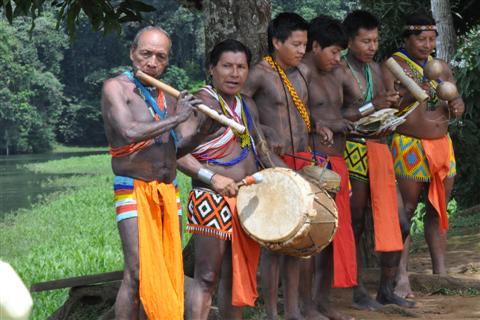
In a large gazebo, Milo, an elder, explained, the Embera culture, translated by JosÚ. Twenty-two families live in the village in thatched huts surrounded by colourful tropical flowers. The village women prepared food over an open fire at the side of the gazebo. We were treated to a large coned shaped leaf filled with cooked fish and plantain cakes. JosÚ had brought some cold drinks, including beer. Lunch ended with large platters of fresh fruit. What a pleasant picnic.
The Embera people sell homemade carvings and crafts as a source of income. We selected a beautiful carving of a harpy eagle (national bird of Panama) by Milo. The Embera sang and danced for us, inviting us to join them. They presented all the ladies in the group with crowns of hibiscus. Some of the group agreed to have tatoos dyed on their arms or legs. A very gentle, friendly people
Back to Gamboa Rainforest Resort for some birding in the rain.
We settled in for a pleasant dinner at the resort restaurant.
New Birds Today
70. Keel-billed Toucan
71. Green Heron
72. House Wren
73. Common Moorhen
74. Green Kingfisher
75. Lemon Yellow Tanager?
76. Prothonatory Warbler
Saturday, October 30, 2010: Birding Pipeline Road Day
Bill had pre-arranged for a birding guide to take us to the
Pipeline Road, an emergency road built by the Americans to ensure
oil supply between Colon on the Caribbean and Panama City on the
Pacific, a well known birding hot spot. His birding friends Susan
Goods and Jane Burgess had recommended JosÚ Carlos Garcia info@birdingpanama.com.
JosÚ Carlos agreed to take five us in his van: Bill, Barbara,
Bruce, Cathy and Catherine.
JosÚ Carlos picked us up on schedule at 6:45am at the Gamboa
Rainforest Resort. We had a full morning of hiking the road,
peering into the dense jungle. Cathy discovered the flighty blue
morph butterflies. Bruce was happy to see his first toucan.
Catherine made detailed birding notes which she shared with Bill
later. JosÚ Carlos was very observant, pointing out a two-toed
sloth, white-faced monkeys and howler monkeys as well as birds.
The howler monkeys were crashing through the tree tops and, when
they started their loud calls. Bruce said it sounded like lions
roaring. Bird highlights included Chestnut-manibled toucan,
White-tailed trogon, Red-capped manakin, Black-necked puffbird
and Purple-throated fruit crow. Catherine listed 53 species for
the morning.
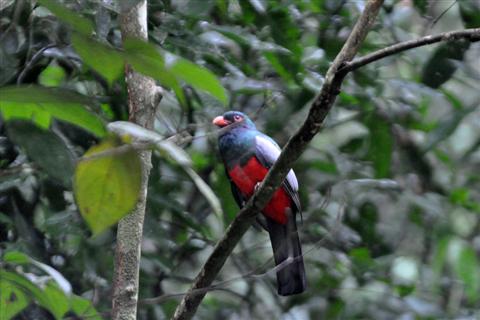
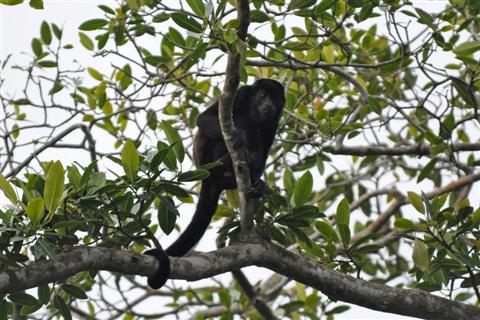
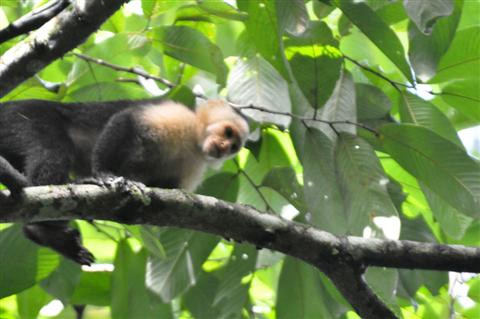
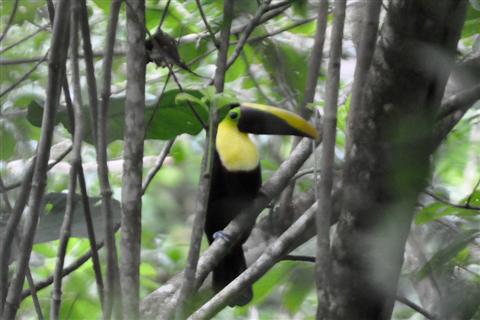
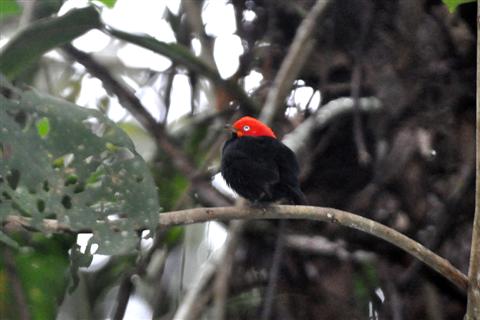
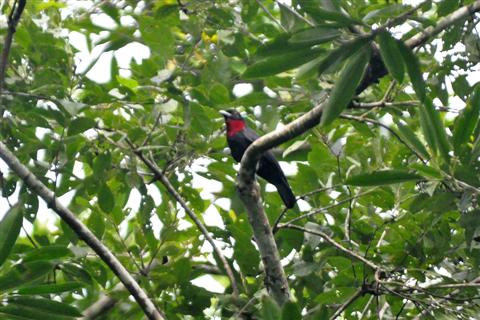
As we were heading into Gamboa to check out some hummingbird
feeders, it started to rain heavily, so we decided to head back
to the Resort. Our trip group was boarding the bus, so we thanked
JosÚ Carlos for a super morning and joined our group to travel
to the pier where we would board ship for the transit of the
Canal..
Today we would begin our crossing of the Panama Canal on board
the Discovery, our catamaran vessel. We were pleased to see our
sporty boat at the pier. JosÚ’s parents arrived to meet us
– it was his mother’s birthday so he was pleased to
treat her to lunch. After lunch at Alberto’s Cafe nearby, we
boarded our new home.
We met our ten member crew and received a welcome from Octavio,
our cruise director. Bill was very pleased to learn he was a
birder. http://ibc.lynxeds.com/users/octavio-rios
JosÚ remained with us too, so we were well looked after.
We settled into our cabin with a view – the Portobelo.
Then we emarked for Taboga Island. Most of the group opted for a tour of the island town but Bill and Barbara decided to try kayaking.
We boarded a tandem kayak and, like magic, a metal ledge
lowered our kayak into the water. We kayaked across the bay with
JosÚ and a support motor boat. Over the rocky shore we spotted
an osprey. We paddled to the other side of the bay and found a
large number of brown pelicans roosting. When we returned to the
Discovery, like magic again, we paddled up to the ship and the
metal ledge rose, bringing us to deck level for an easy exit from
our kayak.
We rinsed the salt water out of our clothes (no spray skirts) and
JosÚ hung them to dry over the warm ship generator.
After dinner, JosÚ presented Surinder (from Augusta, Georgia)
with a birthday cake and a Panama Canal souvenir puzzle. He
seemed pleased with the celebration. Octavio then presented a
video about the Panama Canal.
From our cabin, we enjoyed the twinkly lights of the large ships
at anchor.
New Birds Today
77. Tropical Mockingbird
78. Gray-headed Chachalaca (H)
79. Double-toothed Kite
80. Yellow-headed Caracara
81. Bat Falcon
82. White-tipped Dove
83. Mealy Parrot
84. Greater Ani
85. Great Potoo
86. White-necked Jacobin
87. Blue-chested Hummingbird
88. White-tailed Trogon
89. Slaty-tailed Trogon
90. Black-breasted Pufbird
91. Collared Aracari
92. Chestnut-mandibled Toucan
93. Cinnamon Woodpecker
94. Crimson-crested Woodpecker
95. Plain-brown Woodcreeper
96. Cocoa Woodcreeper (fomerly Buff-throated)
97. Western Slaty-Antshrike
98. Checker-throated Antwren
99. Dot-winged Antwren
100. Bicolored Antbird
101. Yellow Tyrannulet
102. Forest Elaenia
103. Social Flycatcher
104. Acadian Flycatcher
105. Dusky-capped Flycatcher
106. Lesser Kiskadee
107. Rusty-margined Flycatcher
108. Purple-throated Fruitcrow
109. Blue-crowned Manakin
110. Red-capped Manakin
111. Southern Rough-winged Swallow
112. Green Honeycreeper
113. Red-legged Honeycreeper
114. Blue-black Grosbeak
115. Yellow-backed Oriole
116. Scarlett-rumped Cacique
117. Yellow-rumped Cacique
Sunday, October 31, 2010: Locks and Hallowe’en Day
This morning we travelled under the soaring Bridge of the
Americas and entered the Panama Canal at Miraflores locks, the
Pacific Ocean entry. A canal pilot joined our captain to guide us
through.
Luckily, a broad band of hawks migrating to South America
passed over our ship while we were in the first lock. Octavio
announced the different birds as they flew over. Later he
reported that over 10,000 birds were officially counted –
mostly Turkey Vultures, Swainson’s Hawks and Broad-winged
Hawks.
We shared our two locks with two other vessels, one in front and
one behind. The one in front of us was a large barge and required
guiding by the electric mules so we got a good view of them in
action.
It was a short trip through Miraflores Lake to the Pedro Miguel
lock. Once we cleared this we entered the Culebra Cut, a 14 km
man-made channel. It is being deepened and partially straightened
as part of the canal expansion. Enlarged sections had terraced
levels to prevent erosion. Lots of equipment and workers.
We entered Gatun Lake, created by a dam on the Chagres River.
This provides a 30 km passage to the Gatun locks on the
Caribbean.
We anchored on Gatun Lake. We were treated to a nature cruise.
JosÚ led a large group in a small cruise boat. Octavio took the
five “birders” in a zodiac.
The sightings were impressive: monkeys, two-toed sloths, Snail Kites, Yellow-headed Caracaras, herons, toucans...
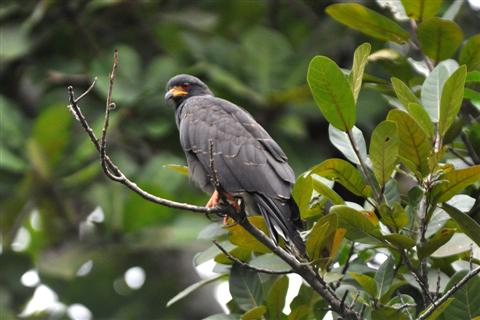
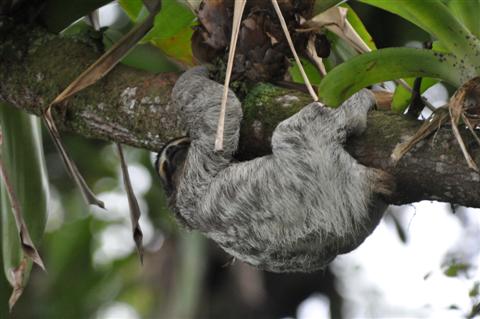
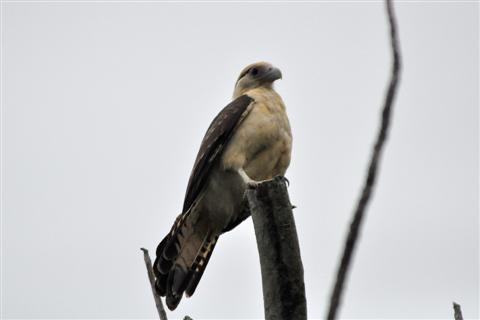
Although it was raining softly when the tours were over, a few
of us decided to go kayaking. It was Cathy’s first
experience in a kayak. Bill and Bruce were startled by a caiman
right beside their kayak. As usual, we loved being out on the
water.
We returned to the Discovery to discuss our canal and nature
adventures over dinner. JosÚ was busy putting up orange and
black Hallowe’en balloons in the dining room. Those of us
without a mask received a colourful eyepiece.
After dinner we carved small gourds. So we celebrated
Hallowe’en in a unique way in the Panama Canal while Grant
was serving trick and treaters at home.
New Birds Today
118. Swainson’s Hawk
119. Broad-winged Hawk
120. Osprey
121. Laughing Gull
122. American Kestrel
123. Limpkin
Monday, November 1, 2010: Locks and San Lorenzo Day
Before we left Gatun Lake, our bus met us on a road beside the
lake. We drove into San Lorenzo Park. We joined the nature group
to walk slowly along the road to Fort San Lorenzo.
We were pleased to see a variety of wildlife, such as howler
monkeys, two-toed sloths, Violaceous Trogon, Zone-tailed Hawk,
Fork-tailed Flycatcher. When we reached the old Spanish fort we
discovered stone ruins, a moat and an amazing view of the Chagres
River flowing into the Caribbean Sea. JosÚ passed out ziplock
bags of fresh fruit, refreshing us hot hikers. On the bus ride,
our driver pointed out a Tyra (like an otter) and a Coati (small
rodent) as well as some sloths.
We returned to our ship for lunch while we were waiting for our first of three locks in the Gatun locks to open up. This time we shared a lock with a massive car carrier which was directly behind us, overshadowing our little vessel. Bill spotted Red-lored Amazon Parrots and some Royal Terns over the front of our ship before the last lock opened. JosÚ announced the winners of the pumpkin carving: Chip and Bette Jane (from Maine).
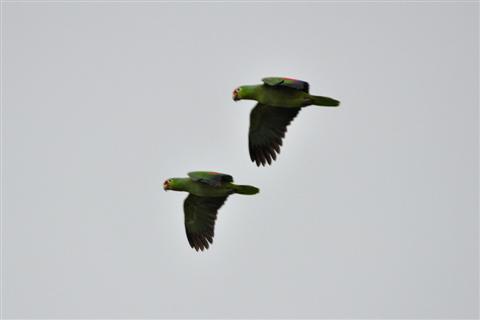
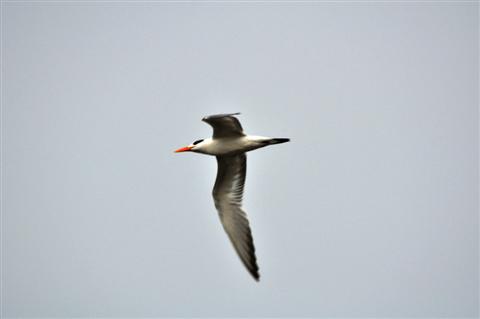
After two hours we entered the Caribbean Sea. As it was 4:45pm the Captain decided to speed ahead to Portobelo bay where we would dock for the night. It was a very bumpy two hour trip with the swells causing the ship to rock. Both Barbara and Cathy had to lie down. Bill had a glass of wine and worked on bird identification. Our chef, Chantal, had to wait until we anchored to prepare a farewell dinner for our last night on the Discovery. Cathy decided to continue resting. Barbara’s gravol helped her recover. The meals on the Discovery were amazing so she was pleased to be able to attend the dinner and watch the lights around the harbour.
New Birds Today
124. Pied-billed Grebe
125. White-collared Swift
126. Chestnut-sided Warbler
127. Chestnut-headed Oropendola
128. Violaceous Trogon
129. Antbird?
130. Zone-tailed Hawk
131. Tri-colored Heron
132. Fork-tailed Flycatcher
133. Black Hawk
134. Red-lored Amazon
Tuesday, November 2, 2010: History, Zipwire and Railway
Day
JosÚ explained that November is a month of special events and
celebrations in Panama. Today was “Day of the Dead”, a
national holiday of respect for ancestors. Also this week
Panamanians would celebrate their separation from Columbia and
their independence. A week of vacation and parades.
The group started the day with either kayaking in the harbour
(too windy to cross over to the mangrove forest) or a visit to
Fort Leonardo nearby. This little harbour has three Spanish
forts, now evident as stone relics. We enjoyed our last
opportunity to kayak in the warm Caribbean water, viewing the old
fortifications from the harbour.
Christopher Columbus was the first European to discover this area
in 1502. He gave Portobelo its name. It was a key port and much
desired by the Spanish, the English and pirates – a long
history of attacks. It is now a quiet village.
After our kayaking outing we had breakfast and toured the engine
room and galley. We said goodbye to the Discovery after a group
photo in the lounge.
The zodiacs transported us to Portobelo for a brief tour of the town, the church and the museum.
Our bus driver, Ramondo, was ready to take us to our next
activity. He drove us back towards the Caribbean canal entrance
where we passed through the busy port city of Colon. It has huge
tax-free warehouses where goods from all over the world arrive by
ship. We stopped for lunch here where we sampled our fourth
Panama beer: Soberana. The restaurant was at a protected cruise
ship docking area sheltered from the main city which has some
dangerous elements, gangs, drugs, crime.
Just outside Colon some adventurous members of our group tried
ziplining. Cathy, Bruce and Bill all tried it enthusiastically.
Barbara decided to take pictures of the zippers. A fun stop.
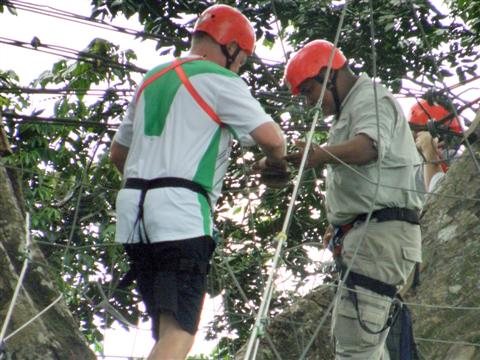
Raymondo dropped us off at the Panama Canal Railway where we
would travel back to Panama City on this historic train line
between Colon and Panama City
We seated ourselves in a comfortable panorama car for the fifty minute ride, back through Gamboa and beside Gatun Lake. As it darkened, the train stopped with jungle on both sides. The air conditioning in our car seemed to get colder and we were bringing out whatever we had, rain gear, etc. to try to keep warm. JosÚ learned that a car on the Bridge of the Americas had fallen onto the track in front of our train. Later we found out that the driver had survived. The accident cost us two hours of time. The train bar closed when they were informed that they could not sell liquor on the Day of the Dead. So, it was a long cool dry wait. Bruce entertained us with a demo of how to clean mud off our sandals with baby wipes.
Finally we arrived back in Panama City about 8:30pm and
decided to travel directly to the Casa Blanca Restaurant in
Colonial Panama for our trip farewell dinner. We quickly forgot
about our muddy shoes and zip wire attire and relaxed to
celebrate our last dinner together. Our teacher members wrote and
sang a song for JosÚ, led by Rosalie.
Back at El Panama hotel, we prepared for our early morning flight
to Atlanta – 4am departure from hotel.
The long trip home ahead of us to reflect on our range of
experiences in Panama.
New Birds Today
135. House Sparrow